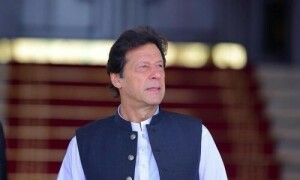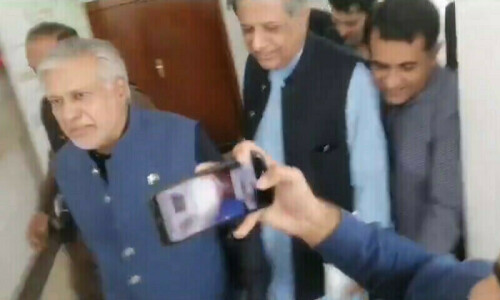‘What is in a name’ is as true as there is much in a name. Names of societies and countries especially carry significance as they are repository of history and human evolution in an unending process of time.
The signs of history and human evolution may not stare us in the face but they are there, hidden under the veneer of what looks like irrelevant litter of the past. Their relevance lies precisely for being a part of debris which organically bricks in the hole that seemingly exists between our present and the past. Similar is the case with our homeland known these days as Punjab.
The name Punjab itself is old, rather ancient if we look at its history. An interesting thing is that the same name has been carried in different languages with the same meanings in different ages.
In the Rig-Veda, the oldest scripture we have, it is called Saptasindhu which means the land of seven rivers ie Sindhu, Jhelum, Chenab, Ravi, Bias, Sutlej and Saraswati (which dried up). At one point Rig-Veda (X. 104.8) addresses Indra, the war lord of Aryan tribes, defied later, thus: “Seven are the divine waters, the gladdening ones, the undiminished, with which you, Indra the fort-breaker, crossed the Sindhu, the nine and ninety.”
Two things are clear. One, Punjab had seven major rivers. Two, it referred to a rout Indra suffered in a battle with Harappa people and fled crossing Sindhu and ninety-nine small rivers or streams.
The epic Mahabharata makes several references to Punjab. Here is one: “Pancha nadyo vahanty, eta yatra pilu vananyaupi/ shatudrushca, vipasha, ca trtiy eravati thatha/ chandrabhaga vitasta ca sindhushashtha bahirgatah… (Where these fivers rivers, viz. Shatadru, Vipasha, the third Eravati, Chandrabhaga and Vitasta flow and where there are pilu-forests and where Sindhu is the sixth to flow out, this country is called Aratta…).
Here is another reference; “pancha nadyo vahanty eta yatra nihsrtya parvatat / Aratta nama Balhika na teshvaryo dvyaham vaset (That region where these five rivers, emerging from the mountains flow, this Aratta country is called Balhika where Arya should not stay even for two days).” Here is yet another: Aratta nama te desha Balhika nam te janah /vast sindhusauvira iti prayo vikutsitah (Aratta is the name of the country, Balhika is the name of the people and they are generally abused as Vasati, Sindhu and Sauvira)”.
Commenting on the above-mentioned, Prof Malti J Shendgi in her remarkable book ‘The Civilized Demons: The Harappans in Rig-Veda’ writes: “The material may be divided under three headings, viz. geographical position, social structure and religious beliefs and practices…”. She further writes about the last passage that it “gives impression that amongst the Balhikas, the Aryan social structure which became a rule in the later days, was not enforced and observed strictly. Thus it was not considered obligatory by the people to hold on to a single
occupation.” In Ramayana, our homeland is called ‘Panchanada’ which in Sanskrit means the land of five rivers.
Achaemenid Empire once ruled us. So in the royal inscriptions of Darius (500 BC) and his successors this region is called Thatagus. While in ancient Iranian literature it is named Haptahindu. ‘Chirak Samhita’ (sixth century BC) is known to be oldest book on Ayurvedic medicines. Its editor wrote that he was Kapil Bali’s son and inhabitant of ‘Panjnad’. Greek called it Pentopotamia, the land of five rivers. Alberuni wrote in his famous book ‘Kitabul Hind’ that towards the west the country was called ‘Panjnad’, the place where five rivers converged.
Now a few words about the current name ‘Punjab’. It comprises two words; Panj+Aab. Panj means five. It is very common word which we find in Punjabi, Sanskrit and Persian. Aab means water in Persian. So Punjab means five waters, in other words five rivers. The sixth Sindhu is implied as the five rivers fall into it and it forms a kind of natural boundary of Punjab, geographically at least. Linguistically and culturally Punjab is much bigger.
According to scholar Asif Khan, the word Punjab is found in Kashmiri Pundit Som Dev’s book ‘Katha Sarit Sagar’ (12th century). Shah Nimatullah Wali made certain prophesies in 1152. The one about Punjab goes like this: “Az qalbe Panjabe kharaj shawand nari / Qazba kunand Muslim, bar mulk Ghasebana / Punjab, shehere Lahore, hum Derajat Bannu / Kashmir mulk mansoor geerand ghaibana.” It is prophesy about the occupation of these lands by Muslims. Asif Khan quotes a part of a letter King Shabuddin Ghauri (1193) wrote to Hindu Rajas: “Ba shuma suleh kunaim ke Sirhind, Punjab o Multan ba ma bashad wa baqi mumalik e Hindustan ba shuma (I reconcile with you on the condition that Sirhind, Punjab and Multan would be under me and rest of the countries in India would be yours).”
In ‘Tabqate Nasiri Minhaj Siraj’ it is written that on the borders of Punjab and Sindh Yaldoz fought a battle against Qutbuddin Aibak. Poet Amir Khusro wrote in his book ‘Muftah ul Fatuh’ that Jaladuddin Khilji played a bloody ‘Holi’ in the land of five rivers.
Talib Amli was the poet laureate of Emperor Jahangir. When he went to Qandhar he felt sad and composed this verse: “Dila mizaj tura Qandhar darkhur nesat / Baya ke deeda am az ashk mulk Punjab asat (O, my heart, Qandhar is not suitable to your temperament / I see in my tears the country called Punjab).”
The name Punjab isn’t just a name. It evokes our history and culture but above all our people’s suffering and dreams in a land of rivers which is otherwise endowed with natural riches. Let’s end the piece with a verse by Maulana Grami: “Baramad harf Punjab az zabanum /zaban shud mauje kausar darr dahanum (The moment my tongue uttered the word Punjab / it turned into a wave of celestial water in my mouth).”
Note: Prof Malti J Shendgi’s ‘The Civilized Demons: The Harappans in Rig-Veda’ and Asif Khan’s ‘Nik Suk te hor Nik Suk’ inspired this piece. — soofi01@hotmail.com
Published in Dawn, September 25th, 2023















































Dear visitor, the comments section is undergoing an overhaul and will return soon.